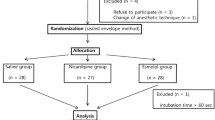Abstract
Purpose
The main purpose of this study was to examine the effectiveness of the timing principle with 1 mg kg−1 rocuronium for rapid sequence intubation. As secondary outcomes, propofol and lidocaine with or without remifentanil were examined to note their effects on the cardiovascular responses to laryngoscopy and intubation.
Methods
Thirty patients were randomly allocated to one of two groups of 15 patients each: a lidocaine-treated group (L) and a lidocaine/remifentanil-treated group (LR). Thirty seconds after lidocaine 1 mg kg−1 with or without infusion of remifentanil 1 μg kg−1 min−1, all patients received a bolus of rocuronium 1 mg kg−1. Shortly afterwards, patients were given propofol 2–2.5 mg kg−1. Intubating conditions and cardiovascular responses were observed 60 s after rocuronium. The time to spontaneous recovery of visible train-of-four (TOF) counts of 4 was observed at the thumb during 1.0–1.5% end-tidal sevoflurane and remifentanil anesthesia.
Results
All patients had excellent or good intubating conditions. Hypertension and tachycardia during laryngoscopy were well prevented in group LR, whereas they were significantly observed in group L. The times to reappearance of TOF counts of 4 were comparable in all groups [mean (SD); 63.6 (8.6) min in group L and 63.5 (11.6) min in group LR].
Conclusion
Application of the timing principle with 1 mg kg−1 rocuronium is beneficial for rapid tracheal intubation. Co-administered lidocaine, remifentanil and propofol can definitely suppress cardiovascular responses during laryngoscopy and intubation.
Similar content being viewed by others
References
Culling RD, Middaugh RE, Menk EJ. Rapid tracheal intubation with vecuronium: the timing principle. J Clin Anesth. 1989;1:422–5.
Koh KF, Chen FG. Rapid tracheal intubation with atracurium: the timing principle. Can J Anaesth. 1994;41:688–93.
Ng A, Smith G. Gastroesophageal reflux and aspiration of gastric contents in anesthetic practice. Anesth Analg. 2001;93:494–513.
Janda M, Scheeren TWL, Nöldge-Schomburg GFE. Management of pulmonary aspiration. Best Pract Res Clin Anaesthesiol. 2006;20:409–27.
Nelson JM, Morell RC, Butterworth IVJF. Rocuronium versus succinylcholine for rapid-sequence induction using a variation of the timing principle. J Clin Anesth. 1997;9:317–20.
Sieber TJ, Zbinden AM, Curatolo M, Shorten GD. Tracheal intubation with rocuronium using the “timing principle”. Anesth Analg. 1998;86:1137–40.
Fuchs-Buder T, Claudius C, Skovgaard LT, Eriksson LI, Mirakhur RK, Viby-Mogensen J. Good clinical research practice in pharmacodynamic studies of neuromuscular blocking agents II: the Stockholm revision. Acta Anaesthesiol Scand. 2007;51:789–808.
Kirkegaard-Nielsen H, Caldwell JE, Berry PD. Rapid tracheal intubation with rocuronium. A probability approach to determining dose. Anesthesiology. 1999;91:131–6.
Andrews JI, Kumar N, van den Brom RHG, Olkkola KT, Roest GJ, Wright PMC. A large simple randomized trial of rocuronium versus succinylcholine in rapid–sequence induction of anaesthesia along with propofol. Acta Anaesthesiol Scand. 1999;43:4–8.
Davidson JAH, Gillespie JA. Tracheal intubation after induction of anaesthesia with propofol, alfentanil and i.v. lignocaine. Br J Anaesth. 1993;70:163–6.
McKeating K, Bali IM, Dundee JW. The effects of thiopentone and propofol on upper airway integrity. Anaesthesia. 1988;43:638–40.
Barker P, Langton JA, Wilson IG, Smith G. Movements of the vocal cords on induction of anaesthesia with thiopentone or propofol. Br J Anaesth. 1992;69:23–5.
Park HJ, Lee JR, Kim CS, Kim SD, Kim HS. Remifentanil halves the EC50 of propofol for successful insertion of the laryngeal mask airway and laryngeal tube in pediatric patients. Anesth Analg. 2007;105:57–61.
Yazicioglu H, Muslu S, Yamak B, Erdemli O. Laryngeal mask airway insertion with remifentanil. Acta Anaesthesiol Belg. 2005;56:171–6.
O’hara DA, Fragen RJ, Shanks CA. Comparison of visual and measured train-of-four recovery after vecuronium-induced neuromuscular blockade using two anaesthetic techniques. Br J Anaesth. 1986;58:1300–2.
Kim KS, Cheong MA, Lee HJ, Lee JM. Tactile assessment for the reversibility of rocuronium-induced neuromuscular blockade during propofol or sevoflurane anesthesia. Anesth Analg. 2004;99:1080–5.
Lowry DW, Mirakhur RK, McCarthy GJ, Carroll MT, McCourt KC. Neuromuscular effects of rocuronium during sevoflurane, isoflurane, and intravenous anesthesia. Anesth Analg. 1998;87:936–40.
Suzuki T, Mizutani H, Miyake E, Fukano N, Saeki S, Ogawa S. Infusion requirements and reversibility of rocuronium at the corrugator supercilii and adductor pollicis muscles. Acta Anaesthesiol Scand. 2009;53:1336–40.
Turan A, Memiş D, Karamanlioğlu B, Süt N, Pamukçu Z. The prevention of pain from injection of rocuronium by magnesium sulphate, lignocaine, sodium bicarbonate and alfentanil. Anaesth Intensive Care. 2003;31:277–81.
Abou-Madi MN, Keszler H, Yacoub JM. Cardiovascular reactions to laryngoscopy and tracheal intubation following small and large intravenous doses of lidocaine. Can Anaesth Soc J. 1977;24:12–9.
Tam S, Chung F, Campbell M. Intravenous lidocaine: optimal time of injection before tracheal intubation. Anesth Analg. 1987;66:1036–8.
Albertin A, Casati A, Federica L, Roberto V, Travaglini V, Bergonzi P, Torri G. The effect-site concentration of remifentanil blunting cardiovascular responses to tracheal intubation and skin incision during bispectral index-guided propofol anesthesia. Anesth Analg. 2005;101:125–30.
Acknowledgments
This study was performed using the institutional fund.
Author information
Authors and Affiliations
Corresponding author
About this article
Cite this article
Suzuki, T., Aono, M., Fukano, N. et al. Effectiveness of the timing principle with high-dose rocuronium during rapid sequence induction with lidocaine, remifentanil and propofol. J Anesth 24, 177–181 (2010). https://doi.org/10.1007/s00540-010-0880-y
Received:
Accepted:
Published:
Issue Date:
DOI: https://doi.org/10.1007/s00540-010-0880-y




